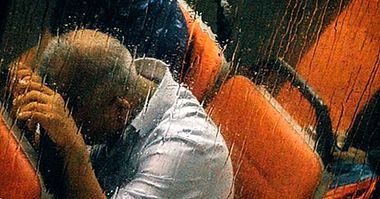Those who see without looking: the curious phenomenon of heminegligencia
A camera, when it is recording, captures images. But behind that camera there is always a realization team that pays attention and gives importance to the information that has been captured. It elaborates the information, manipulates it, selects it, understands it. It processes it to then show the result of that processing to an audience that will store that information, and use it later.
Our brain works the same . We get stimuli, we receive information from the outside constantly through our eyes and just like a team would do, it is processed by our brain, and stored, to be used at other times of our day to day.
But what would happen if the lens of that camera captured images for a while, but then to all the information it has captured was not paid attention and simply stayed there, useless, useless? This is what happens to people who have an attention disorder called heminegligencia or spatial neglect.
- Related article: "The 15 most frequent neurological disorders"
What is heminegligencia?
Heminegligence is a disorder that appears as a result of an acquired brain damage (for example, a brain tumor, ischemia or hemorrhage) in the right posterior parietal lobe, mainly. Precisely to be in the right hemisphere and how the pathways that go up to the brain are contralateral (they cross each other, going from one side to the other), everything that the left eye captures is what is not processed later.
The key to this disorder is that the left part of what is in the focus of attention is not processed , you do not pay attention.
People who suffer from this disorder live some situations in their day to day like the following: they make up only the left loop of the face (since the right side of the face that is reflected in the mirror is captured by the left eye), At the time of the meal they only eat the right side of the plate and everything must be placed on this side. When they try to read, they fragment the sentences and the words, so it does not make any sense what they read and they must invent it. They also have problems to write, since they do not handle the spaces well. In addition, this disorder also affects the extremities of the left side, since as they do not see them and they forget to use them.
- Maybe you're interested: "The 15 types of attention and what are their characteristics"
How is it different from blindness?
The difference between blindness and heminegligence is that a person with blindness can learn to locate objects in a 360 degree space , with difficulties, of course, but achieving it. This is due, in part, to the fact that the person knows there is "something" in that space and is aware that even if he does not see the objects that are there, in the end he manages to achieve a small normality in his life despite the limitations . On the other hand, for a person with heminegligencia their space only has 180 degrees, because the other 180 for it are not. People with this disorder have anosognosia (lack of awareness of disease).
As a result of this we can think that, in some occasions, that "realization team" that we have in our brain is more important than the lens that captures images, because in the future we may be able to change that lens for another if it is damaged But... Can we one day be able to change a damaged cognitive function for another that is functional?
Currently there are various techniques to rehabilitate people suffering from this pathology. The goal of such rehabilitation is not to cure heminegligence, since this is a chronic disorder. However, we work to teach people to live with the disorder and have a better quality of life. Some of the most effective techniques are the use of prisms, (placing these next to the right eye so the person could see what is on the left looking at the mirror) and cognitive reeducation (teaching the patient to turn the head to the left enough to be able to perceive all its visual field with the right eye).
Author: Maria Vega Sanz



















